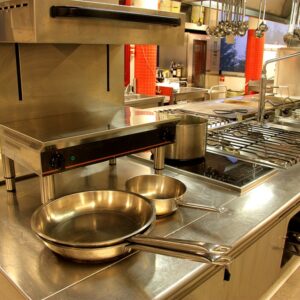For those who have yet to hear about ghost kitchens, sadly, they are not even remotely related to Halloween, though some of them are undoubtedly scary. Call them ghost kitchens, call them virtual kitchens, or call them virtual restaurants – whatever you call them, these recent gastronomic incarnations are here to stay.
The term “ghost kitchen” is becoming so popular, it’s on Merriam-Webster’s list of “Words We’re Watching.” They define “ghost kitchen” as, “An establishment that cooks and sells food to be delivered to a residence, but that, unlike a restaurant, doesn’t have its own space for dining or pickup.”
Ghost kitchens are on their way to becoming a trillion-dollar industry. But while there are some benefits to having ghost kitchens, there are plenty of downsides.
Krenar Camili, a New Jersey lawyer, warns of the legal complications of ghost kitchens. “When several restaurants operate out of the same ‘ghost kitchen’ and the nature of these kitchens are temporary, it can become increasingly difficult to track down who owns what. This could become a legal issue for someone looking to sue a food business that is simply a brand name operating from a ghost kitchen.”
For example, the online foodie site, Eater, just announced this new Montreal “restaurant”: “Asada Fries and California Burritos are the focus at this new-to-Montreal ghost kitchen. San Francisco Bay Area french fry specialist Man vs. Fries is based out of the new virtual restaurant facility Q-ZN.”
What does this even mean? If I were to order from there and became ill to the point where a lawsuit was something I’d consider, who could I potentially successfully sue? While that’s not a simple question to answer, there is significantly more ambiguity and complexity when measured against the same process with a traditional local restaurant.
Yet we need to get ready, as the “restaurants” of the future are going to take all shapes and sizes, few recognizable as traditional eateries. The food show, Munchies, recently did a segment on a Toronto noodle shop that has gone viral (in the good way) for its healthy and delicious East Asian meals. Not only is this soup dispensary, for lack of a better term, in a storage unit behind the hair salon owned by the same person, its food is made in a ghost kitchen. In a fascinating business model tweak, all of the food is prepared in the ghost kitchen then packaged in a way that it can be made ready to serve through rapid sous-vide preparation. The storage unit isn’t even close to being equipped as any food cart is – it’s basically for refrigerating and quick final preparation and presentation.
This new elemental disconnect from production to consumption is going to change our conception of what a restaurant is. While the notion of a pop-up restaurant or food truck challenged many of us for the better part of a decade, these ideas are now seen as normal, as they have set, identifiable, physical locations. Even if you didn’t know who and what technologies were helping to get your food ready to eat (most mobile food is prepared at least in part elsewhere before final preparation on-site) you knew that you could walk up to a truck, order lunch, and get it on the spot.
As we intellectually grapple with the notion of, say, 15 delivery-only “restaurants” being run from one small ghost kitchen or even part of the kitchen space in an existing and unrelated restaurant, more and more of these spaces will at first dot and then blot out the food landscape in many of our cities.
The more disconnected we are from the simple, traditional knowledge that comes from eating in a restaurant and knowing that they are preparing our food, the more complex the legal landscape becomes. With each degree of separation (ghost kitchen, third-party delivery service, common areas to leave and collect deliveries) the legal chain of responsibility and potential liability becomes more complex.

